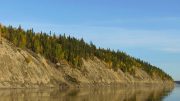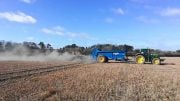
The minimal variation in CO2 levels may indicate that the climate is more responsive to alterations in atmospheric CO2 concentrations than previously thought.
The emergence of forests did not decrease the concentration of CO2 in the atmosphere.
It is challenging to envision a world without trees today, however, in the past before the emergence of forests and human beings, the land was populated by shallow, shrub-like plants.
For a long time, researchers globally have believed that the decrease in atmospheric CO2 levels and the cooling of the Earth’s climate was caused by trees.
Until today at least. Now researchers from the University of Copenhagen, using a new method, have learned that the small vascular plants that populated the Earth before turning into trees 385 million years ago may have played a greater role than previously assumed.
“A new method has enabled us to calculate the CO2 level in the atmosphere in the past based on plant fossils. This enables us to understand climate changes when CO2 levels increase. Among other things, the first results suggest that small changes to the CO2 level have a greater effect on the climate than previously assumed,” says Associate Professor Tais W. Dahl from the Globe Institute at the University of Copenhagen.
The study can help us understand the processes controlling the climate on Earth and e.g. the impact of trees on the climate today.
“We initially applied the method to the time before forests emerged – a time which researchers agreed was characterized by high levels of CO2 in the atmosphere. We used to think that the emergence of forests reduced the amount of atmospheric CO2 on Earth. But instead of 4,000 ppm, which is the amount researchers assumed was found on the planet back then, we have shown that the figure is more likely around 600 ppm, which is not far from the level we are approaching today,” says Tais W. Dahl and adds:
“The fact that the CO2 level has not changed that much may mean that the climate is more sensitive to changes to atmospheric CO2 levels than previously assumed. The Earth’s climate sensitivity is a much-debated topic because it is affected by various processes such as cloud formation, water vapor, and ocean currents, which may intensify changes in temperature.”
By studying both live plants and ancient plant fossils, the researchers are now able to calculate the amount of CO2 in the atmosphere at the time when the fossils were alive. The new method makes it possible to calculate CO2 levels of previous climates more accurately.
We need to focus on “weathering”
Tais W. Dahl and his colleagues do not believe trees are as good at removing CO2 from the atmosphere as previously believed. The vascular plants with shallow roots that existed before trees emerged do this much more effectively.
“We believe the emergence of primitive vascular plants, not forests, causes the greatest reduction in CO2 levels. This is because vascular plants have shallow roots which, unlike tree roots, cannot hold on to nutrition from the ground and therefore need to absorb more nutrients from the subsoil through weathering of minerals,” says Tais W. Dahl.
And weathering plays a key role in understanding how we can reduce the level of CO2 in the atmosphere.
“Plants remove CO2 from the atmosphere for two reasons. The first is probably the one we are most likely to think of, namely that the plant itself absorbs CO2 and turns it into sugars. But plants also absorb nutrition from the soil or rock they live on by dissolving rock particles through chemical weathering. For this process, plants need CO2 to dissolve minerals. This is actually the primary reason why plants and trees reduce CO2 levels over longer periods of time,” explains Tais W. Dahl.
It is also the reason why trees may not be as significant as Tais W. Dahl and his colleagues’ predecessors used to believe. Because trees are not as good at weathering as small plants.
“Plants need to absorb more nutrition from minerals in the ground than trees, and this leads to more weathering. Trees do not move and they have well-functioning root systems, which helps them hold on to nutrition and creates a more closed system. Therefore, over time, primitive plants do more weathering than trees, and it is mainly through weathering that trees and plants help remove CO2 from the atmosphere,” explains Tais W. Dahl.
A step on the road to more solutions
Does that mean that we should start planting a lot of vascular plants – instead of trees and forests – to curb the amount of CO2 in the atmosphere? Not quite, says Tais W. Dahl.
“Trees are good for other reasons; biodiversity is one. And then we need to remember that the solution to present-day climate changes is not simply more weathering. Much more is needed to counter climate changes.”
The study increases our knowledge of what controls atmospheric CO2 levels and how sensitive the climate is to changes to the amount of greenhouse gases in the atmosphere. And then it can help give us an idea of how natural processes affect CO2 levels.
“Finding solutions is key. But to find solutions, we need to know as much as possible about the processes that can potentially remove CO2 from the atmosphere, e.g. planting trees and increased weathering,” says Tais W. Dahl and adds:
“To understand how this works on a global scale, and what the consequences are, it is a good idea to look at what happened in the past when the Earth saw major changes and these mechanisms changed. And that is what this study does.”
Reference: “Low atmospheric CO2 levels before the rise of forested ecosystems” by Tais W. Dahl, Magnus A. R. Harding, Julia Brugger, Georg Feulner, Kion Norrman, Barry H. Lomax and Christopher K. Junium, 20 December 2022, Nature Communications.
DOI: 10.1038/s41467-022-35085-9









“The fact that the CO2 level has not changed that much MAY mean that the climate is more sensitive to changes to atmospheric CO2 levels than previously assumed.”
An alternative interpretation is that something else is the dominant driver of temperature changes so that the impact of CO2 is negligible.
Something the authors have overlooked is that the roots of shallow, vascular plants affect a smaller volume of soil than trees with deep roots. Furthermore, shallow roots tend to recycle nutrients in the soil A-horizon, whereas trees, with deeper roots, actually get near and into the bedrock underlying the soil, actually weathering the original mineral grains.
Something that they don’t acknowledge is that elevation controls the balance between chemical and physical weathering. Plant coverage varies with elevation as well. That is, what happens at sea level is different from what happens in alpine environments, especially above the tree-line. Their model is essentially two-dimensional, while the real world is three-dimensional. Plate tectonics is responsible for orogenies, or mountain building. The maximum and average elevations changes over time as mountains grow and then are leveled by erosion. I don’t think that they have a fully developed and integrated model yet, and they may be premature in their speculations about the role of CO2.
The paper seems driven by the need to support the current, ever-shakier, narrative.